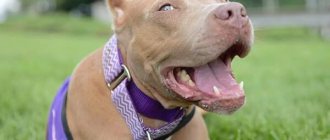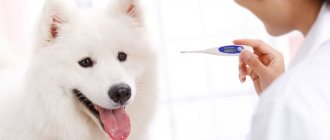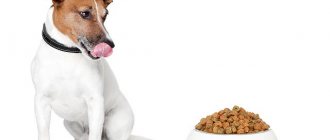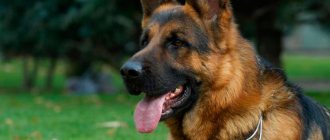The body of almost all dog breeds is covered with hair.
Wool is a kind of barrier between the dog's body and the environment. It can be compared to a thermos: in winter it helps to retain heat, in summer it protects against overheating. But, unfortunately, if the heat is too long, the heat remains in the body and it becomes very difficult to get rid of it due to the fur that prevents cooling. A natural way of thermoregulation is sweating. During this process the body cools down. But the question is: do dogs sweat? Yes, they sweat, but it happens differently for them than for people.
General information
There are two types of sweat glands in a dog's body:
- The first type helps cool the body, the second type does not.
- The second type is the main one in dogs and is called apocrine.
Any hair on a dog's body contains an apocrine gland. This sweat gland has another property - it releases hormones through which dogs transmit information to each other. But these sweat glands do not help remove moisture through the skin, which could help reduce a dog's body temperature. The sweat coming out through the apocrine glands is of an oily consistency. It has no smell. But when it encounters skin bacteria, it develops an odor.
The first type of sweat glands is called merocrine. In dogs, this type of gland is located on hair-free skin, namely on the pads of the feet and on the nose. The sweat produced by these glands consists of water and sodium chloride. Areas of the skin that are free of hair have the ability to remove moisture through the eccrine glands. This can only happen when the body heats up.
The mechanism of heat transfer in dogs
A dog covered with thick fur does not need a mechanism for evaporating sweat from the surface of the body. The main heat loss in dogs occurs through the respiratory organs, but part of the heat loss occurs from the surface of the body by contact.
Polypnoetic
The dog’s long tongue is richly penetrated with blood vessels that “bring” heat. On the tongue, mucous membrane of the palate and cheeks, ducts of small salivary glands open, secreting a liquid secretion. When you breathe, moisture evaporates, taking with it heat from the blood. But when breathing, the air does not fully come into contact with the mucous membranes, and where it comes into contact, it is quickly saturated with water vapor.
For heat exchange, it is necessary that the masses of air passing through the respiratory tract be significant. In the process of intense breathing, a lot of physical work is performed, during which a lot of energy is expended and a lot of heat is released.
In order to ensure rational rotation of air, nature has provided a counterflow mechanism - the dog inhales air through its nose and exhales it through its mouth. In hot climates, evaporation and heat loss increase significantly, but it is not enough to maintain thermal homeostasis in the dog’s body. Moreover, the inhaled hot air is not very capable of absorbing heat from the blood.
A healthy dog has a cool and moist tip of the nose, which is ensured by the evaporation of sweat glands and secretions from the mucous membrane. Warm air, passing through the winding, folded nasal passages, abundantly covered with moisture, cools and enters the lungs. At the boundary of the warm flow from the internal “core” of the body and cool air, condensation of water vapor from the atmosphere occurs, due to which the mucous membrane does not dry out, and the level of evaporation is maintained with each act of breathing.
In addition, the large nasal gland is the supplier of moisture to the nasal cavity. Humans do not have such a gland, so its functions remained unstudied for a long time. Its sole purpose is to maintain moisture in the dog's nose, which increases the cooling of the inhaled air flow. In a sense, this gland performs the same function as the human sweat glands.
If the ambient temperature is comfortable for the dog, then it breathes through its nose. Measurements of the temperature of the air inhaled and exhaled through the nose showed that its t = 29 ° C - slightly higher than the animal’s body temperature. And when exhaling air through the mouth, it is + 38° C. Moreover, with 1 liter of air, when exhaling through the mouth, 27.7 cal of heat is “carried away” from the body, which is two times higher than when exhaling through the nose! By redirecting the flow of exhaled air, the dog can regulate heat transfer without changing the breathing rate.
As the ambient temperature increases, the dog experiences thermal dyspnea, in which the respiratory rate increases approximately 100 times per minute. With such work, it would seem that such an amount of heat should be released that would negate the operation of the counterflow mechanism.
But in the middle of the last century, Yu. Crawford described the process of resonant oscillations, in which the respiratory system oscillates at its own frequency, requiring minimal muscle effort. This explains the insignificant heat production during intense breathing.
Contact or hemological
Heat transfer during contact exchange occurs from hot blood to cooler air. The amount of heat released into the atmosphere is affected by the speed of blood flow and its volume. The regulation of vessel diameter is influenced by the central nervous system. Thermal exchange by this mechanism occurs in places where there is less thermal protection - on the stomach, in the anal-genital area, on the ears, on the pads of the paws. As the temperature rises, blood vessels dilate, blood flow increases, and heat transfer increases.
The diameter of blood vessels is influenced by both hormone levels and the activity of the hypothalamus. In the skin and mucous membranes of organs there are α- and β-adrenergic receptors, sensitive to the level of adrenaline and norepinephrine. When α-receptors are activated, the vessels constrict and heat transfer decreases, and when β-receptors are irritated, heat release through the skin increases. Thermal stimulation of the hypothalamus in dogs causes increased blood flow, vasodilation and increased heat loss.
Thermoregulation of dogs
Any living organism controls its body temperature with the help of the brain. There are cold-blooded and warm-blooded animals. Dogs are warm-blooded animals, just like cats, which maintain the desired body temperature. In fact, dogs do not sweat like humans, although they do have glands on their bodies that resemble sweat glands.
They are located on the muzzle, namely on the nose, and on the paws between the toes and on the pads of the toes. The liquid released from the glands on the paws dries quickly and refreshes. She has no smell. The secretion coming out of the glands on the muzzle has a thicker consistency and smell. This is what gives rise to the smell of wet dog.
REFERENCE! You can understand that a dog is sweating only by seeing wet marks from its paws.
Dogs know how to cool down differently. To do this, they stick out their tongue and breathe quickly through their mouth. When they are hot, the dog's body temperature increases. In addition to the temperature, salivation begins to increase. You may also notice your nose and eyes are wetter than usual. Saliva tends to evaporate quickly due to its salt content, which cools the dog's mouth.
REFERENCE! When a dog breathes through his mouth with his tongue hanging out, his nose and ears become cold. This is explained by an increase in capillaries and rapid cooling of surfaces. Due to the faster heart rate, blood passes through the vessels faster and cools.
Due to increased salivation, the body spends salts and electrolytes, and this in turn inhibits the breakdown of carbohydrates, which are the main source of heat. And since they are not absorbed, the dog’s body cools down faster.
A brief excursion into dog physiology
Periodic sweating is not limited to cold-blooded people. The blood of lizards heats up or cools down depending on temperature conditions. In cold weather, reptiles hibernate, and in warm weather they are active.
The body temperature of four-legged pets does not depend on external conditions. Their body maintains its optimal value (37.3-39.3°C) on an ongoing basis.
Overheating dogs
Thermoregulation is a natural process, so it always works if the dog is absolutely healthy. If a dog is sick, it cannot cope with the increase in body temperature on its own and may overheat and even die.
Overheating can cause:
- - the dog has a fever in response to an infection or virus;
- — the dog has experienced severe stress or excitement;
- — increased air temperature;
- - keeping the dog near heating devices or a fire;
- - keeping the dog in the car in the heat;
- - hard, exhausting workouts in the warm season;
- - lack of water, as a result - dehydration;
- - inability to hide from direct sunlight.
IMPORTANT! The standard temperature for dogs is 38-39 degrees.
You can talk about a dog overheating only after measuring its temperature. If the temperature is still higher than standard, the dog must be left alone in a cool room for 15-20 minutes. If your dog experiences vomiting, excessive salivation, pupils of different sizes, dizziness and other uncharacteristic conditions, you need to quickly provide the necessary first aid and get to the veterinarian as soon as possible.
How to help your dog cool down during the hot season?
It is not difficult to save your dog from overheating during the hot season. Follow simple safety rules to reduce the risk of heat stroke. Prepare a corner for your pet that is protected from direct sunlight. A bath or wide basin with cold water will help reduce the overall temperature. However, you should not create drafts so that your pet does not catch a cold.
A moderate diet and constant access to drinking water will help you avoid heatstroke. When walking, always take a container of clean water with you. During the hot season, try to reduce the animal's physical activity. If classes are necessary, move them to a cool time of day: evening or early morning.
If it was not possible to avoid overheating, immediately provide first aid to your pet:
- Move your pet to a cool place. On the street it can be any shaded place; in an apartment it can be placed in the bathroom.
- Provide the animal with drink and fresh air. However, avoid sudden cooling under air conditioning.
- Try to cool your pet's body with a wet rag or towel. Do not use very cold water.
- Give the animal some water and leave it at rest.
After providing first aid, your pet should be taken to a veterinarian immediately. Remember that heat stroke can cause serious pathologies and even death of a dog.
Other cooling methods
Dogs don't sweat as much as people. This happens due to the fact that more often the dog’s body cools itself with the help of its tongue. If a dog gets hot, it will stick out its tongue and pant rapidly. In hot weather, dogs make about 400 respiratory cycles, in normal weather - only about 40 cycles. Air is inhaled through the nose and moisture comes out of it, after which warm air comes out through the mouth.
As a result, the nose becomes cold. In addition, due to the fact that saliva evaporates, the tongue also cools. Then the blood that passes through the tongue also cools.
The spleen controls the dog's body temperature. It is quite large and due to this, a decent amount of blood can be stored in it, which, if necessary (when the body heats up), can be released. At the base of a dog's neck there are many small veins and arteries that separate the head from the body. Therefore, the brain, which is very sensitive to high temperatures, is protected from extreme heat. For these reasons, dogs are more resilient than humans and many other animals.
How do they process thermoregulation?
The sweat gland system of animals is less efficiently developed than that of humans. Because of this, all owners need to know what to do if their dog is sweating and how to protect them from overheating. Sweating through the pads of the paws does not cool the body, so it is only a sign of increased temperature, but not a way to reduce it.
An effective method is language. Excess moisture evaporates through its surface and the temperature gradually decreases. Rapid breathing helps saturate the blood supply with oxygen and replace hot air from the lungs with cool air from the environment.
Usually this method is enough to regulate the pet’s heat exchange. However, when a dog overheats, other areas of the body that do not have fur can also cool down. This can be observed when a puppy or adult dog lies on its belly on the ground.
Clinical manifestations of the disease
An allergic reaction can develop at any age, but children suffer from it much more often.
Respiratory system symptoms:
- difficulty breathing with whistling;
- dyspnea;
- chest pain, suffocation;
- cough, wheezing;
- nasal congestion, sneezing.
You can conduct an analysis to find out if you are allergic to cats in a special laboratory.
“Ocular” manifestations: redness of the eyes, swelling, increased lacrimation, itching, blurred image perception.
“Skin” symptoms:
- swelling;
- itching and peeling;
- redness of the skin;
- soreness.
Systemic disorders include: tachycardia, decreased blood pressure, nausea, pale skin, dizziness, loss of consciousness.
On our website Dobrobut.com you can make an appointment with a doctor who will tell you what to do if you have an allergy to cat hair. In addition, the clinic offers diagnostics, including special tests.
Symptoms of overheating in a pet
The natural process of thermoregulation is effective only when the dog is in normal condition. If the animal is sick or has chronic problems with the immune system, an increase in body temperature can cause overheating. Elevated body temperature can cause serious complications and even death of your pet.
In order to provide timely help to your pet, you need to know not only the signs and main symptoms indicating overheating. It is very important to reduce the risk factor in order to prevent body temperature from rising to a critical level.
► Causes of overheating.
- Stressful situation, increased arousal.
- Fever, viral or bacterial infection.
- Too active training, physical activity.
- Increased ambient temperature.
- Being close to heating objects.
- Dehydration.
- Direct sunlight.
It is possible to determine whether a pet is overheated only after measuring its body temperature. In order not to confuse some signs with symptoms of overheating, you should also carefully study the pet's behavior.
► Signs of overheating.
- weakness, general decrease in well-being;
- unsteady gait, loss of balance, apathy;
- cardiopalmus;
- dryness and pallor of the mucous membrane;
- convulsions;
- loss of consciousness;
- increased salivation;
- vomiting and other signs of illness.
Infectious skin diseases
The group of infectious diseases includes parasitic, fungal, viral, and bacterial infections.
Parasitic diseases
The most common parasitic skin disease in dogs and cats is fleas. They settle on the animal's body and cause itching, which causes the pet to scratch furiously and chew itself. Dogs often develop an allergic reaction to the secretion secreted by fleas during bites. It increases itching, causes redness of the skin, scabs, and purulent bumps.
The only way out in this situation is to treat your dog for fleas in a timely manner. Drops, sprays, tablets, and collars help cope with the task.
Parasitic infections include ticks. The most common are scabies and demodicosis, which cause itching and baldness. Previously, in veterinary medicine, these skin diseases of dogs were considered incurable. Now tablets are prescribed for treatment - Nesgard, Simparica, etc. With regular use, the number of mites returns to normal levels.
Fungal skin diseases in dogs
The most dangerous fungal infection is ringworm, caused by a dermatophyte. Bald patches covered with scales appear on the face, ears, tail, and paws. They are surrounded by dull fur with broken hairs. Some dogs develop itchy bumps that can develop into large bumps with ulcers.
The dog can also be affected by:
- Malassezia dermatitis, the fungus that causes it, is safe and lives on pets for life. Activated when the immune system is weakened, against the background of flea dermatitis, demodicosis.
- Candidiasis - develops when the candida fungus is activated, which is part of the microflora and normally does not harm. Symptom – ulcers on the mucous membranes, the appearance of gray-white plaques.
- Onychomycosis is a nail fungus that causes nails to crumble and fall out.
What to do?
Fungal skin diseases of dogs require immediate diagnosis and treatment. To protect your dog from ringworm and other fungi, vaccinate him with Vakderm. This medicine, as well as Fungin forte spray, can be used to treat the disease. An ointment that has antiseptic, astringent properties and stimulates cell regeneration helps a lot.
Bacterial infections
The most typical form is purulent inflammation, when bacteria penetrated an open wound and caused rotting. In this case, salicylo-zinc ointment will help, which kills the infection and accelerates cell healing.
Another pathology that a dog may encounter is Alaban rot, caused by E. coli toxins. Manifested by redness, erosions, ulcers, fever, anorexia, vomiting. The pathology is dangerous because it can cause kidney damage and death of the pet. Treatment is symptomatic; blood transfusions may help.
Prevention
Of course, the best solution would be complete isolation from the allergen. But if you are not ready to part with your pet, the following measures will help minimize contact with the irritant protein:
- daily wet cleaning;
- daily ventilation of the room, especially before bedtime;
- washing hands after contact with animals;
- using an air purifier;
- Do not allow animals into the room of an allergic person.
If you have any questions, please make an appointment. During a personal conversation, the doctor will answer them and tell you whether cats do not cause allergies. Registration takes place by phone and online.
Related services: Pediatric allergology
Treatment
Doctors use the following medications to treat allergic conditions:
- antihistamines;
- enterosorbents;
- corticosteroids;
- decongestants.
Antihistamines: Tavegil, Claritin, Diphenhydramine.
Corticosteroids are especially effective for allergic symptoms, however, they are not safe. The drugs have a number of side effects and can only be prescribed by a specialist who will tell you how allergies to cats manifest in children and how to help your child at home.
Can dogs sweat too much?
In humans, a condition in which they sweat excessively even in a cool environment is called hyperhidrosis. Whether similar conditions occur in dogs is not entirely clear.
According to PetHelpful, dogs get sweaty paws when they are stressed. Although no one knows why this happens, it is believed that excess moisture provides better traction on certain surfaces, which helps your pet escape from the source of stress. This type of sweating usually goes away after getting out of a stressful situation.
If your dog's paw pads produce excess moisture, it is best to ask your veterinarian about possible causes and ways to reduce stress in your sweaty pet.
How does a cat allergy manifest in children?
Allergic manifestations to cats in most cases occur in children in the form of:
- difficulty breathing;
- "barking" cough;
- swelling and redness of the skin;
- watery eyes and redness of the eyes;
- nasal congestion.
If these symptoms occur, parents need to make an appointment with a pediatrician, who will prescribe a diagnosis and provide treatment.
Important: in most cases, the manifestation of signs of allergy to pets in infants is diagnosed in families in which one of the parents already suffers from some type of allergy.
Seborrheic dermatitis
When the sebaceous glands work normally, the coat glows with health and beauty. If the production of sebaceous secretions is disrupted, seborrhea develops. Skin diseases in animals come in 2 forms:
- Dry – the sebaceous glands produce little secretion, which leads to excessive flaking, dandruff, and hair loss. The main causes of seborrhea in dogs are poor nutrition, stress, and mites.
- Oily – develops due to increased activity of the sebaceous glands. Symptoms of oily seborrhea in dogs - the hair sticks together at the base, oily plaques appear. The main reason is hormonal imbalances, poor diet, and mites.
What to do?
If you notice symptoms of seborrhea in dogs, contact your veterinarian for treatment. If your dog has hormonal imbalances, you need to get tested and adhere to the prescribed therapy.
A properly selected diet will improve your pet's health. In the treatment of seborrhea in dogs, medications that improve the condition of the skin and coat will help:
- Essential 6 spot-on (LDCA). It contains oils that need to be rubbed into the skin. They soothe and moisturize irritated epidermis.
- Complex supplements that contain B vitamins, Omega-3 acids and other beneficial substances that improve the condition of the skin and coat (8in1 Excel Brewers Yeast).
Where are sweat glands located in tetrapods?
Sweat glands in dogs are located throughout the body. The fewest of them are in the lower part of the body, and the most of them are on the back and tail.
Unlike humans, only a small part of the glands is responsible for cooling in four-legged pets. They are called merocrine or eccrine. They are found on completely hairless and practically hairless areas: on the muzzle and paw pads.
When the body heats up, the merocrine glands secrete a secretion consisting of water and sodium chloride (table salt). The sweat on the face is thicker than on the pads and has the specific smell of a wet dog. For this reason, the liquid formed on the paws evaporates very quickly. Wet prints on the floor can only be seen when there is significant warming outside.
The second type of sweat glands is called apocrine. They do not take part in cooling the body, since their main function is the release of hormones. Every hair is penetrated by these glands. The oily secretion they produce acquires a unique odor after mixing with skin bacteria. It is through this that animals read information about each other when meeting each other.











